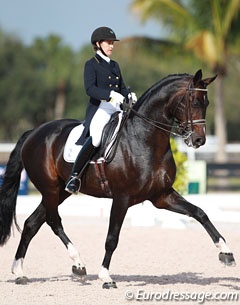
Putting the horse on the bit seems simple enough, but the reality of that concept extends far beyond the literal understanding of those words. My idol Nuno Oliveria summed it up pretty nicely when he said that, “putting the horse on the bit means feeling that the poll flexes, the back rises, the haunches become active."
There is no mention in the Master's quote about the reins, nor the hands, nor the mouth of the horse, because contact is a consequence of what happens when the horse finds balance, impulsion and self carriage. Therefore a rider can never seek to put the horse on the bit through the use of reins, but more through the use of gymnastic exercises which teach the horse to seek the contact through a loose and supple body.
"The horse must seek the contact by impulsion and the use of the hindquarters," Oliveira added.
Often we see riders who pull on the reins and then push with the leg, and believe they have the horse on the bit, when in actual fact the horse has just been compacted between two opposing forces. When asked to flex within that compression the horse will stiffen and eventually resist.
Why could Nuno ride his horses with his reins in loops and yet his horses were on the bit? Because his horses were relaxed and supple and he could keep the horse forever searching for the contact with the use of his seat and subtle flexions to keep the horse on the aids.
Concentrating on the contact, the rein aid, and the placement of the bit in the horse's mouth will never achieve the desired result. A rider must work on the elasticity and impulsion of the horse in order to achieve an “on the bit” partnership.
Well known trainer Jan Bemelmans says that this term really means having control over the whole body of the horse, from the hind leg over the back to the horse's mouth. “When a horse is not on the bit it feels a bit like there is not control, either the horse is too strong, or too light. On the bit must mean that there is a light connection between my hand and the mouth of the horse," he stated. "If the horse is on the bit I am also able to control the neck position of the horse, and I can easily alter the neck position of my horse at any time, from collected frame to a stretching frame.”
Jan notes that when a horse is not on the bit you will likely see a very unharmonious picture with an unsteady neck position and a tail that is waiving through frustration. The horse that is not on the bit is not relaxed through his body.
Nuno would always advise that relaxation of the mouth alone was not enough; the horse must learn to relax throughout his entire body. "The relaxation of the mouth alone is not enough. It can be deceptive, because it does not necessarily lead to lightness. It has to be accompanied by the relaxation of the entire horse. When he relaxes the back, it will definitely have repercussions in the mouth," he said.
Once you feel that you can get the horse constantly searching for that intangible contact, with a feeling that you are in control of his body, and he is engaged and pushing himself forward, then you must remember not to overdo it. "It is a mistake to keep the horse on the bit for too long. He must be relaxed at the walk on the long rein regularly and afterwards he must be carefully put back together again," Oliveira stated.
Imagine a puzzle and as you assemble all the pieces your horse gains strength, but once the puzzle has been put together the horse must work hard to keep it, and so we as riders must learn to dissemble the puzzle at intervals in order to reward our horse. In the beginning when you are still searching to feel when your horse is on the bit, it might take you 20 or 30 minutes to get the feeling of it, but each time you put the puzzle together, the pieces will join together a little more easily, and the horse will learn the aid and be more quick to respond when you begin to ask for it.
As you're building your puzzle, begin at the back, ask yourself what the hinds legs of your horse are doing? Then slowly move through the horse discovering where his weight is tending to go and correct these imbalances through exercises that teach him to bend or move away from the leg. When you feel that “ah ha” moment, relax, let the horse stretch, and try next time to build your puzzle a little more efficiently.
One day, you will simply need to go over your checklist of relaxation and having the horse on the bit will be as easy as one-two-three!
by Sarah Warne - Photo © Astrid Appels